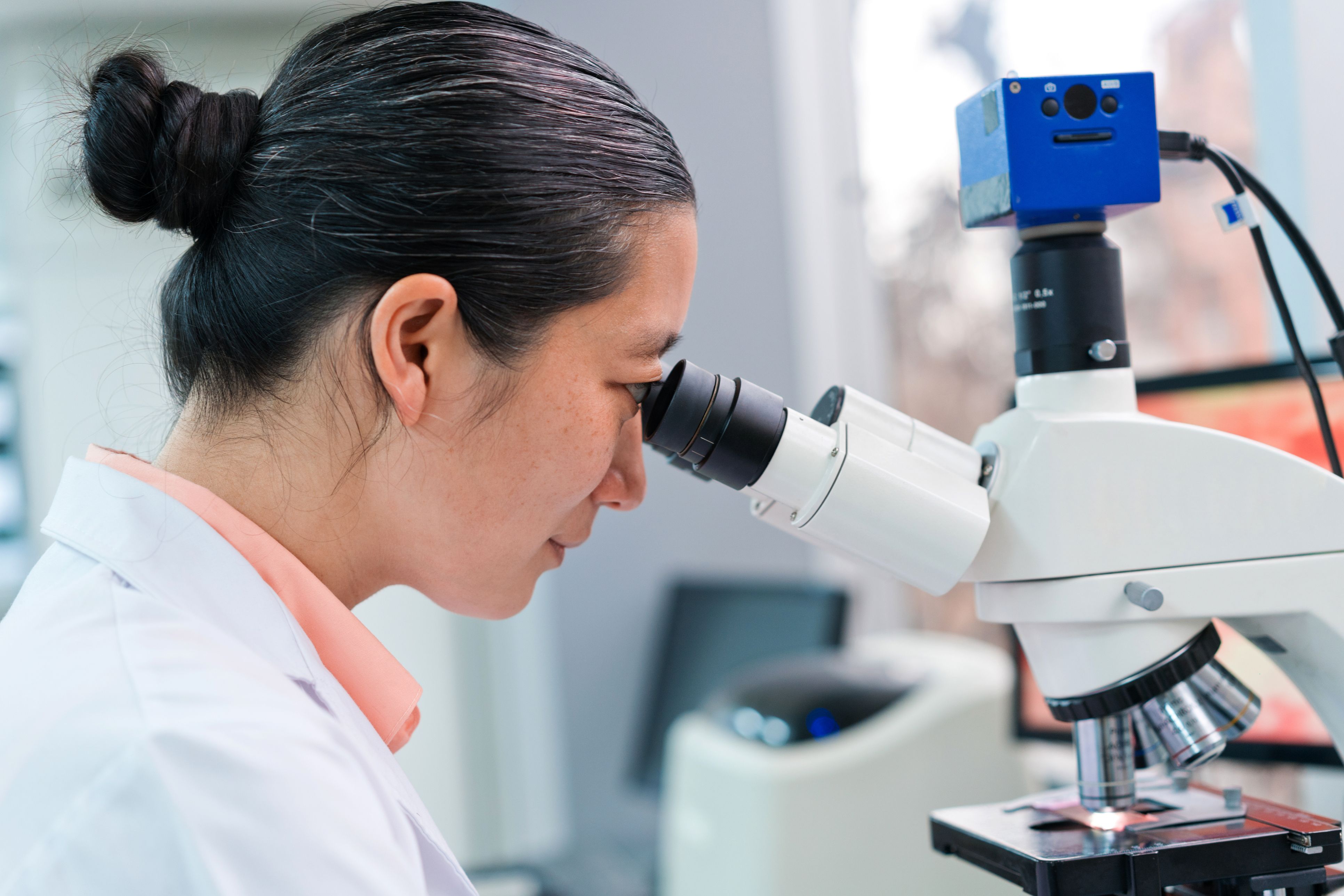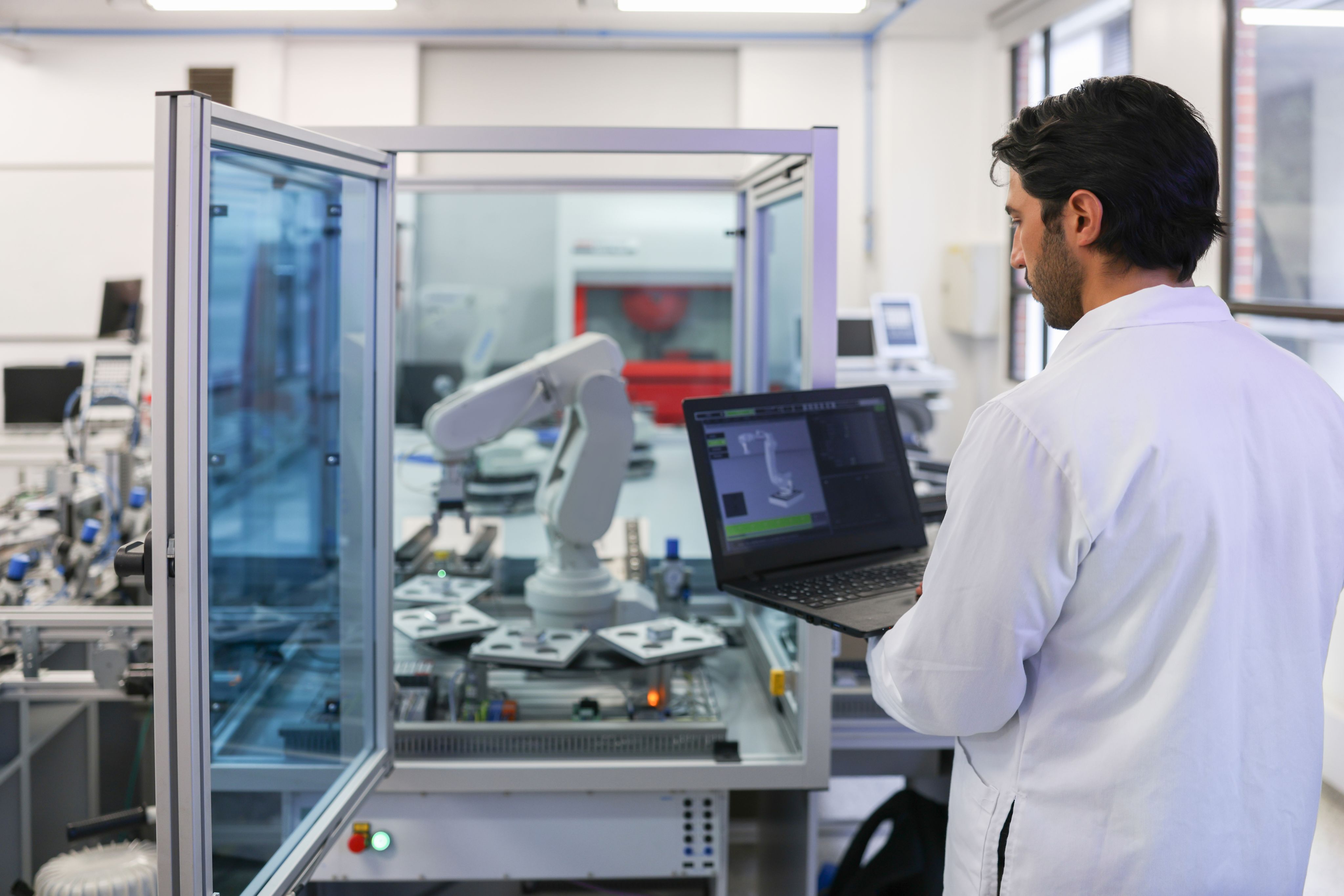
Contents
Foreword
The Lord Mair CBE FREng FRS NAE
Getting ready for the 6G revolution
Professor Emad Alsusa
Britain’s chip strategy: smart focus, but does it pack enough punch?
Professor John Goodacre
Designing life: how synthetic genomics could hold the key to sustaining the world
Professor Patrick Cai
Compound semiconductors – building UK resilience in a transactional world
Professor David Binks and Dr Daniel Dyer
Improving the resilience of computer systems with software compartmentalisation
Dr Pierre Olivier, Dr Hugo Lefeuvre and John Kressel
Quantum technologies: a new frontier of the information age
Dr Thomas Elliott and Dr Jayadev Vijayan
Engineering security for the UK’s cyber ecosystem
Professor Daniel Dresner
Unlocking the north-west’s industrial biotechnology potential
Professor Aline Miller
In silico technologies: the future of UK life sciences?
Professor Alejandro Frangi
Foreword
The Lord Mair CBE FREng FRS NAE
Chair of the House of Lords Science and Technology Select Committee
There is a strange paradox occurring in the world of science and technology. Anyone who reads the technology press will read breathless stories about Artificial Intelligence that will soon utterly transform the world, powered by astonishing computer chips that can process billions of calculations a second. They will read about the de-extinction of species and genetic editing that could cure diseases or even reverse ageing. They will read about a forthcoming revolution in quantum that could upend computing by harnessing the strangeness of the subatomic. And yet, at least for the UK, to paraphrase the economist Robert Solow, “you can see the new technological age everywhere but in the productivity statistics.”
The frontiers of technological development are indeed exciting. We look to technology to solve our intractable social problems, from improving the health of an ageing society, to finally taking steps to mitigate climate change, to providing the economic growth that will support our public services. This is in the light of renewed global competition in an increasingly uncertain world.
The UK is pursuing a national science and technology strategy. Under the Department for Science, Innovation and Technology, and Ministers Peter Kyle and Lord Vallance, the government’s five critical technologies have been identified as Artificial Intelligence, semiconductors, future telecommunications, engineering biology, and quantum technologies. These strategic priority areas will see specific funding from UK Research and Innovation, and each have specific strategies.
The House of Lords Science and Technology Committee, which I now Chair, investigated engineering biology in a recent inquiry. It found this is an area with immense potential for the UK in areas such as healthcare and sustainability, but argued that we risk failing to scale our promising early-stage technology companies, such that many of the benefits of the UK’s world-leading research ultimately flow overseas.
Subsequent work by the Committee has highlighted the problems of financing and scaling UK science and technology companies more broadly. We believe that bold actions will be needed to invest in research and development, to promote and procure the latest technologies to help companies to grow, to train or attract talented and skilled scientists and engineers to work in the UK, and to finance the most promising science and technology companies so that they can grow domestically.
The UK has seen idle productivity since the 2008 financial crisis, leading to stagnant real wages and pressure on public services. This lies at the root of many of the problems politicians struggle to deal with. If we want critical technologies to be part of the solution, the UK’s science and technology strategy must be pursued right across government with vigour, ensuring that we can benefit from these technologies, grow our domestic industries, and deploy them widely. It is not a question of whether we can afford to invest in critical technologies and their adoption, but a reality that we cannot afford not to.
This vital contribution from academics at The University of Manchester offers valuable evidence-led recommendations, providing policymakers with guidance and ideas that can advance and safeguard the future of critical technologies in the UK.
Getting ready for the 6G revolution
Professor Emad Alsusa

As the world continues to embrace what 5G networks can do, the next frontier in wireless communication – 6G – is rapidly moving from theoretical concept to active research and development. Expected to be standardised later this decade and rolled out in the 2030s, 6G promises a giant leap forward, enabling unprecedented speeds, near instantaneous response times, massive connectivity for trillions of devices, and seamless integration of physical and digital worlds.
This future network will not merely be an evolution of 5G; the vision is a foundational platform capable of supporting truly immersive experiences like holographic communication, pervasive artificial intelligence (AI) integration, and advanced applications supporting diverse sectors from healthcare and manufacturing to transportation and environmental monitoring.
Given the long lead times required for policy development, spectrum allocation (allocating specific frequency bands for the different services), and infrastructure deployment, it is crucial for policymakers and regulatory bodies to engage now, to shape 6G’s development and ensure it serves social and economic goals effectively.
Getting from spectrum to society
The advent of 6G brings with it a unique set of challenges and opportunities. The sheer scale of expected data traffic and the need for ultra-high reliability necessitates access to vast amounts of radio frequency spectrum. 6G is anticipated to utilise much higher frequency bands, including sub-THz and THz frequencies (a kind of ‘superfast lane’ of wireless, ranging from roughly 100 GHz to 10 THz), which are currently largely unexplored, underutilised, and lack clear regulatory frameworks. Establishing how these bands will be allocated, licensed, and managed globally and nationally is a fundamental task that requires urgent attention to prevent bottlenecks and ensure efficient use.
Deploying networks capable of delivering 6G's promises may involve new infrastructures requiring significant investment, potentially impacting urban planning and raising concerns about aesthetics and environmental footprint. The integration of AI into the network architecture introduces complex questions around data privacy, security, algorithmic bias, and network control that fall squarely within the regulatory domain. There is also the critical challenge of ensuring that the benefits of 6G are accessible to all, bridging rather than widening the digital divide, and supporting a diverse range of innovative use cases safely and effectively. Proactive policy is needed to guide investment, foster competition, ensure security, and establish the necessary legal and ethical guidelines for this advanced technological era.
At The University of Manchester, research that sheds a vital light on the technical feasibility and potential implementation strategies for the underpinning of these advanced 6G networks is taking place. Already, this research has made significant contributions to the understanding and application of advanced multiple access techniques, such as Non-Orthogonal Multiple Access (NOMA). These findings are highly relevant to policy discussions around spectrum efficiency (how well you’re using the available radio frequencies), as NOMA explores ways for multiple users to share the same frequency and time resources simultaneously. This means potentially increasing network capacity and accommodating the massive connectivity demands of 6G, without requiring equally vast amounts of new spectrum. Similarly, research in areas like advanced signal processing and interference management is crucial for realising the potential of exploiting higher frequency bands like sub-THz, where signals behave differently, and interference is a complex challenge. Providing insights into how sophisticated signal processing algorithms can overcome these technical hurdles will enable the effective integration of sensing (detecting information) and communication at extremely high data rates.
Our research is also exploring energy-efficient network architectures and novel transmission techniques, directly addressing concerns around the environmental impact of vastly expanded network infrastructure. In combination, these research areas provide critical data and theoretical frameworks that can inform regulatory decisions on spectrum access, network deployment strategies, and performance standards by demonstrating what is technically achievable and how network resources can be optimised for efficiency and capacity.
Shaping 6G through proactive policies
Shaping 6G through proactive policies Based on the evolving technical landscape of wireless communications, several key policy recommendations emerge for the successful and beneficial development of 6G.
Regarding spectrum allocation and management, The Office of Communications (Ofcom) must prioritise the identification and clearing of sub-THz and THz frequency bands for future mobile use. Drawing from research on advanced spectrum sharing techniques, flexible and dynamic spectrum management frameworks should be developed, in partnership between Ofcom and The Department for Culture, Media and Sport (DCMS), with input from both industry and academia. These frameworks should enable more efficient use of both new and existing spectrum resources, reducing wastage and working with legacy systems and other services, moving beyond rigid, exclusive licensing models where appropriate.
The ambitious target proposed for 6G is that it should have a 100 times greater energy efficiency compared to 5G, meaning 6G must transmit significantly more data for the same amount of energy. Sustainability needs to be deeply integrated into the design of 6G from the outset and incorporating intelligent network management which is able to adapt the network resources to traffic demands, putting unused components into sleep modes and even turning off entire cells during low-traffic periods, will be necessary. For such ambitious targets to be achieved, there is a role for government to incentivise the telecommunications industry to adopt and deploy green communication technologies and low-energy network architectures to significantly reduce power consumption.
Targets, efficiency, policies and ways forward
A multi-pronged approach using a combination of incentives and disincentives is likely to be effective. These could include policies such as reduced corporation tax, or enhanced capital allowance in proportion to their investments into more energy-efficiency approaches or equipment, grants and subsidies in the form of direct funding for relevant research and development, with additional market incentives such as green bonds and carbon credits. As for disincentives, these could include setting stricter limits on energy consumption, carbon taxes, and tying licensing and renewals to certain energy efficiency requirements.
Setting clear, ambitious targets for energy efficiency and potentially supporting research and pilot projects in areas like energy-neutral network nodes could drive the development and adoption of sustainable 6G infrastructure aligned with net-zero emission goals.
To ensure digital inclusion and accessibility, government must implement proactive policies to guarantee equitable 6G rollout across urban, rural, and underserved areas, preventing the exacerbation of the digital divide. This could involve targeted subsidies for infrastructure deployment in commercially challenging areas, mandates for infrastructure sharing among operators, and promoting public-private partnerships. Universal service obligations should be updated to define and ensure access to high-speed 6G connectivity as a baseline, supported by policies to promote affordability for all citizens.
Concerning use-case specific regulations, recognising that 6G will enable transformative applications, policymakers and regulators need to establish cross-sector dialogues and develop agile regulatory frameworks. For airborne platforms like unmanned aerial vehicles (UAVs) and high-altitude platform systems (HAPS) integrated into communication networks, coordination with aviation safety and airspace management bodies is paramount.
For critical ultra-reliable, low-latency (quick response time) services such as remote surgery and autonomous vehicles, new performance guarantees, certification processes, and liability frameworks must be developed in collaboration with relevant industry and safety bodies. For smart city infrastructure, urban planning policies need to evolve to facilitate the dense deployment of smart technology, ensuring seamless and efficient urban connectivity while addressing privacy and security concerns.
The transition to 6G presents immense potential for technological advancement and for society. Realising this potential requires proactive and informed policy and regulatory action to be taken. By understanding the technical underpinnings through ongoing research, particularly in crucial areas like spectrum utilisation and energy efficiency, policymakers can develop frameworks that facilitate innovation, ensure equitable access, prioritise sustainability, and enable the safe and effective deployment of transformative applications that 6G promises to deliver.
Ignoring these challenges now means risking the UK's ability to seize the opportunities and avoid the pitfalls in the coming 6G era.
Britain's chip strategy: smart focus, but does it pack enough punch?
Professor John Goodacre

Semiconductors, or microchips, are akin to tiny silicon brains inside everything - from your phone and car to NHS scanners and the nation's power grid. They are essential, yet Britain's role in making them has been, frankly, uncertain. In 2023, the Sunak government unveiled its National Semiconductor Strategy. The strategy identifies where the UK can compete, but nearly two years on from its launch, there are questions to be raised about whether it is bold enough, and if it is being driven with the urgency required.
The strategy acknowledges that the world runs on chips, that the supply chain is fragile (such as the automotive industry grinding to a halt following chip shortages), and that relying too heavily on manufacturing hubs in potentially volatile regions is risky business. It also avoids delusions of grandeur, acknowledging that pouring tens of billions into building massive state-of-the-art silicon factories to compete with global giants was never realistic for the UK.
Instead, the strategy focuses on Britain’s genuine strengths: world-class chip design and intellectual property, cutting-edge research in our universities, and a particular knack for advanced 'compound' semiconductors, which are used in things like radar and high-efficiency power electronics.
The plan promises action: up to £1 billion over a decade (a figure that looked modest even in 2023 compared to US and EU spending), an advisory panel, better access to design tools and prototyping for start-ups, and efforts to boost skills and protect our technology from falling into the wrong hands through the National Security and Investment Act.
However, now the question is one of momentum. Is the UK decisively carving out its niche in compound semiconductors and next-generation design? A strategy document alone doesn't build an industry or secure a supply chain. It needs relentless drive, a faster funding rollout, and perhaps a bolder ambition backing those niche strengths.
Britain has the brains and the heritage in semiconductor innovation, and the government's strategy provides a map. Now it needs to put its foot down and drive, ensuring this smart focus translates into tangible industrial success and national resilience before the global landscape shifts again. The silicon clock is ticking.
Building a blueprint for more secure computing
The UK's National Semiconductor Strategy acknowledges that we can't outspend global giants on mass silicon fabrication. We do, however, have opportunities for research and development. The University of Manchester, with facilities like the National Graphene Institute and expertise in areas such as advanced chip design and compound semiconductors, represents the sort of specialised R&D capability the strategy rightly champions.
Fundamental hardware decisions echo through our entire digital lives, and radical shifts in architecture are possible, and indeed necessary, to meet evolving demands – whether for performance, energy efficiency, or, critically today, security.
The semiconductor strategy also highlights the security risks inherent in semiconductor technology. My work on the Digital Security by Design (DSbD) initiative took a different approach, one that directly addresses a core pillar of the strategy: protecting the UK against security risks. We championed the CHERI principles - Capability Hardware Enhanced RISC Instructions - which build security into the processor's instruction set, the basic language the hardware speaks. It provides fine-grained memory protection, making devastating vulnerabilities like buffer overflows, which hackers have exploited for decades, practically impossible at the hardware level. We built the prototype Morello board, a tangible demonstration of this.
The technology works and is deployable. It is possible to run existing code, often with just a recompile, on CHERI-enabled hardware and instantly eliminate vast swathes of security flaws. This isn't just about preventing attacks; it's about reducing the colossal burden of patching, freeing up developers, and ultimately building more trustworthy systems – essential if the UK wants to lead in critical technologies.
However, proving the technology works is only half the battle. The strategy and a recently published UK Government policy statement correctly identified market dynamics as a challenge, and we now face the critical hurdle of adoption. Concerted action is needed to signal that secure-by-design hardware isn't a 'nice-to-have' but an essential requirement.
Foundational change is possible, and we have a viable blueprint through semiconductors for a more secure digital future, one that aligns perfectly with the UK's strategic goals. We've demonstrated the UK's capacity for deep-tech innovation in semiconductors. Now, we need the collective will to translate that blueprint into the bedrock of our digital infrastructure. The National Semiconductor Strategy provided the map; it's time to accelerate the journey, something the government’s funding can support.
Building on strong foundations
The UK's National Semiconductor Strategy correctly identifies the nation's strengths and the right direction of travel. However, to protect and truly capitalise growth around these advantages, and build a resilient and thriving semiconductor ecosystem, a more decisive, robust, and integrated approach is now essential.
The bedrock of the UK’s current semiconductor expertise, from the foundational principles of DSbD to the advanced capabilities in compound semiconductors, lies within our universities and research institutions. These are engines of innovation, training grounds for future talent, and the source of the intellectual property that underpins our strategic advantage. Yet, this vital sector of higher education research is facing significant headwinds, and the financial model which leaves universities increasingly reliant on project-based funding is inherently precarious. Despite the mechanisms put in place post-Brexit, collaborative research with EU counterparts continues to face challenges, hindering the free flow of knowledge and expertise.
What is heterogenous integration, and how can it help?
While the focus on compound semiconductors is a valuable starting point, the Government's support for design capability must embrace a broader vision centred on heterogeneous integration. This means actively promoting research and development into methods and technologies that allow for the seamless integration of diverse semiconductor components and technologies from different design groups into a single device. This includes combining the power management through compound semiconductors, the high-speed communication and novel computation capabilities of photonics, and the intelligence and control offered by traditional silicon-based digital designs.
By strategically investing in research that fosters this synergistic combination, the UK can achieve significant advancements and develop highly differentiated, competitive semiconductor solutions. This approach would also protect and scale specialist businesses, preventing their inevitable integration into large international companies, as happened previously when specialist IP businesses were absorbed by mega-businesses capable of producing today's leading chips.
The UK Government should invest in a national mainstream fabrication facility focused on immersion DUV lithography. This should be capable of producing the predominant chips used by UK business and academic research, at around the 65nm to 28nm scale. This would mitigate supply-chain shocks by providing a UK source of critical chips over the bulk international sources. It would also support research and innovation, particularly in support of heterogeneous integration, by providing a platform for developing advanced semiconductor solutions that combine compound semiconductors, photonics, and traditional silicon-based designs.
Critically, this capability could unlock economically viable academic research, especially for integrating leading-edge AI chiplet-based technologies, while also supporting evolving concepts such as cryoCMOS (Complementary Metal-Oxide-Semiconductor) technology. This is designed to operate at cryogenic temperatures, typically near or below -269°C, which is particularly relevant in the field of quantum computing, where many components require extremely low temperatures to function, essential for unlocking the potential of quantum computing and its integration with classical semiconductor-based computing. This investment would also stimulate economic growth, create high-value jobs, and foster the development of a skilled workforce in the UK semiconductor industry.
A sustained approach and strategy
Semiconductor research, especially for design prototyping and implementation analysis, dictates non-typical innovation cycles and does not align with current funding arrangements. Maintaining critical research knowledge and experience is essential to realise impact and advance innovation. A sustained approach doesn't just prevent loss - it creates a robust foundation for cumulative experience and innovation, allowing insights from one project to directly inform and accelerate the next. This will therefore secure a decisive competitive advantage in a rapidly evolving sector of research while also increasing the attractiveness of UK-based research activities over those available in the EU and beyond.
By implementing these recommendations, the Government can move beyond simply having a smart focus, to delivering a truly impactful and resilient semiconductor strategy. The UK possesses the intellectual capital and the innovative spirit. Now, it needs the sustained investment, a secure academic research sector, and strategic support to translate that potential into tangible industrial success and secure its place at the forefront of the global semiconductor landscape.
The time for decisive action is now.
Designing life: how synthetic genomics could hold the key to sustaining the world
Professor Patrick Cai

In a world of rising demand for sufficient food, affordable medicines and equitable healthcare, sustainable fuels and safe but effective agrochemicals, there is an increasing need to find new ways to produce these goods at scale. With climate change affecting arable land’s abilities to produce food crops, and many industrial processes relying on harmful chemicals, synthetic genomics is emerging as a technology that could hold the answer.
We have long been able to read DNA, but now we are starting to understand how to write it. By carefully designing a genome (a set of DNA instructions) from scratch, or modifying which genes are present in an organism – such as yeast – scientists are now able engineer these organisms for diverse applications. These include bioproduction of high-value chemicals and biologics, advanced cell therapies, and stress-tolerant crops.
Historically, synthetic genomics has been characterised by expensive, long-term projects reliant on technologies largely restricted to a small number of well-funded, specialised groups. However, recent advances in knowledge and funding in DNA design, synthesis, assembly and delivery are lowering barriers to research and are accelerating advancements, driving the transition from proof-of-concept projects to real-world applications.
Using synthetic genomics to feed the world
One of the largest problems facing the planet today is the need to feed its growing population. However, with many traditionally agricultural regions suffering from extreme weather events, such as floods or drought, crops are failing to thrive, and food production is at risk of being severely impacted.
Research at The University of Manchester is exploring how microbial communities act within an agricultural setting, and how they react to environmental stressors. This knowledge is then used to design plant genomes that are drought-tolerant or able to produce high yields despite growing in unfavourable conditions. Developing plants that can not only grow but thrive in challenging conditions is vital in those places most impacted by climate change such as sub-Saharan Africa, Central America, and low-lying and coastal regions.
Mitigating risk
While these technologies and developments offer vast potential to address large global challenges, they also come with inherent risks. Without proper foresight and control, these genetically engineered organisms may accidentally or intentionally find their way into the natural environment where they could have potentially harmful effects.
To control this, biocontainment mechanisms can be engineered into organisms to prevent them surviving outside of a lab or industrial setting. For example, research has shown using estradiol – a form of oestrogen – provides a way to prevent genetically engineered yeast from surviving in the wild. For the engineered microorganism to thrive, estradiol must be present which is very unlikely to occur in the wild.
In addition to environmental biosafety concerns, synthetic genomic technologies can pose a biosecurity risk because of their potential for dual use. Their now relative ease of access can enable malicious state or non-state actors to recreate and engineer dangerous pathogens, with potentially catastrophic consequences. So, it is imperative and strategic that safeguarding frameworks and technologies are developed and implemented to safely and securely deliver the revolutionary societal and economic benefits while at the same time minimising the risks for misuse.
An international team of world-renowned scientists, including researchers at the Manchester Institute of Biotechnology, have previously appealed to the scientific community to call for a moratorium on all research into mirror life. Mirror life is a mirrored version of an organism: every molecule in the natural world has handedness, they are either left- or right-handed, just like your own hands. Molecules only exist in one form, either left or right, but not both. Scientists had been exploring mirror molecules to better understand natural biology and to see if they offered any potential benefits, however the potential drawbacks outweighed the potential benefits if research continued without the proper legislative and legal frameworks in place.
This kind of foresight is essential when working with newly emerging technologies such as engineering biology as it offers protection for both the research community and wider public, while also preventing intellectual espionage and supporting our ever-growing bioeconomy.
Capitalising on the benefits of engineering biology
The UK is in a unique position to capitalise on its exceptional knowledge sector to commercialise emerging biotechnological advancements, putting itself at the forefront of the biotechnological revolution.
The UK also needs to advance and mature its regulatory frameworks in collaboration with the research community to ensure it supports this rapidly developing sector. When policy develops before the technology, it risks slowing down scientific advances and dampening innovation, exemplified by the GMO (Genetically Modified Organism) regulation in Europe. But when policy fails to keep up with technological development, the consequences have the potential to be catastrophic, as evidenced by the CRSIPR baby scandal in China in 2018, a scientific and bioethical controversy surrounding the use of genome editing following its first use on humans.
The establishment of The Regulatory Innovation Office (RIO) helps position Britain as the best place in the world to innovate by ensuring safety, speeding up regulatory decisions and providing clear direction in line with the UK’s modern industrial strategy. This provides a welcome vehicle for policy development, but the government still has a role to play in urging the RIO to prioritise regulation around engineering biology. Safety mechanisms are instrumental for the deployment of these emerging technologies, but there is a goldilocks zone to be reached for regulation to coevolve with technology.
Alongside regulation, there must also be a level of public support and understanding for technologies that will be adopted into society. Currently, the UK is lacking a public awareness and engagement campaign to effectively communicate the benefits of engineering biology. Lessons could and should be learned from previous genetic projects, and future engagement with the public should take into consideration the need for evidence-based messaging which is vital for the successful implementation of engineering biology into the UK.
Machine-learning in medicine: why data access, education and 'hybrid intelligence' matter
Dr Claudia Lindner

Technologies like Artificial Intelligence (AI) hold the potential to modernise health and care provision in the UK and provide innovative solutions to some of the sector’s most pressing challenges. With ongoing debate around the sector’s use of AI, and the government committed to building an NHS fit for the future, the time to discuss the complexities of putting advanced technologies into healthcare practice is now.
Machine-learning tech to speed up assessment: a Manchester case study
Cerebral palsy (CP) is the most common motor disability among children in the UK. For children living with CP, the risk of hip dislocation is extremely high, leading to severe pain and difficulties with sitting, washing and dressing. Hip dislocation can be prevented by regularly assessing the hip and performing minor procedures promptly when signs of hip problems arise, but if left untreated, it can require extremely invasive surgery and reduce quality of life for patients.
The Cerebral Palsy Integrated Pathway (CPIP) is a national surveillance programme for the assessment of the musculoskeletal system in children with CP. Children receive regular X-ray images for specialists to identify any issues. While taking regular X-ray images for monitoring purposes is beneficial, the assessment of the images for hip displacement is often delayed and early signs can be missed – with staff training, workload, and technology infrastructure creating delays in obtaining manual measurements of hip displacement. Compounding this are measurement inconsistencies between users, as well as errors when inputting data into different systems.
The development of machine-learning technologies, such as the fully automatic software tool – BoneFinder® – developed by academics at The University of Manchester, allows us to automatically assess the position of the hip bones in X-ray images. Such technologies can locate the outline of the bones in the image and use this information to automatically calculate clinically relevant measurements. This includes the automatic calculation of the key measurement used to assess the extent of hip displacement in children with CP.
An automated measurement system has the potential to save clinicians time and to improve patient care by enabling more comprehensive, consistent, and reliable monitoring of hip displacement in children with CP.
Deploying software in clinical settings
The BoneFinder® tool has been validated with data from Alder Hey Children’s Hospital. Tests on clinical images of over 3,000 hips of children with CP show that the tool creates measurements with accuracy similar to doctors. The results demonstrate that the tool works for children whose hips are beginning to dislocate or are dislocated. This allows for reliable and consistent monitoring, aiming to improve patient outcomes through hip surveillance programmes.
The work aligns with Health Data Research UK’s mission to unite the UK’s health and care data by contributing to a national database of hip measurements in children with CP, enabling important future research. The research outcomes are openly accessible, including the technology for automatically outlining bones in radiographs through the BoneFinder® website.
Feedback from some trusts indicated that, ordinarily, it could take months from taking the X-ray to reviewing the data, which sadly delays the interventions and outcomes for the child. The ultimate goal for this tool is to ensure that every child with CP is appropriately monitored for hip migration by speeding up the assessment process and automatically populating the CPIP database, improving the quality of care for children with CP.
Balancing AI and human expertise
A key concept for developing AI-based medical imaging solutions is ‘hybrid intelligence’ - the combination of human and artificial intelligence. One essential mechanism for this collaborative approach is the human-in-the-loop design, where clinicians remain actively engaged in the decision-making process. While developing highly intelligent AI systems is crucial, it is equally important to preserve and enhance human intelligence. Maintaining this balance ensures that clinicians can effectively interact with AI systems without losing their critical judgment and expertise.
The importance of trust in AI systems cannot be overstated. One significant issue with its widespread deployment is the tendency of clinicians to trust AI systems, sometimes even when they are incorrect. This phenomenon, known as automation bias, occurs when users rely too heavily on automated systems, potentially leading to errors in judgment. For example, clinicians are more likely to trust systems that have a higher perceived benefit, which may lead them to unknowingly accept an incorrect decision as correct. Although faith in AI systems is a necessity for their successful adoption, this risk underscores the need for continuous education and awareness to prevent over-reliance on technology, and the requirement for comprehensive education programs to train clinicians on the potential biases and limitations of AI systems. This training should focus on developing critical thinking skills and awareness of AI-induced biases such as automation bias.
It’s also important that these technologies are transparent in their development and performance. One aspect of transparency is providing information about the data used to develop and validate the technology. According to a recent review, many medical imaging solutions – including regulatory-approved AI-based medical imaging systems – lack external validation of their results. Key contributing factors are likely difficulties and delays in accessing relevant clinical care data. Without clear evidence of performance, it becomes challenging to build the trust necessary for the successful implementation and adoption of AI-based healthcare technologies.
Access to data and the future for AI-enabled healthcare
One of the fundamental challenges in developing medical imaging solutions for clinical practice stems from the nature of the data involved. Imaging data may have been collected as part of a study such as UK Biobank, or as part of clinical care. Images collected from study data are easier to access, and very useful for research purposes. In contrast, clinical care data can be difficult to access but are an absolute requirement for developing and validating medical imaging tools that are to be used in clinical practice.
Access to anonymised clinical care imaging data for research purposes needs to be improved to enable faster and more effective research in translational medical imaging. The establishment of secure data environments (SDEs) – data storage and access platforms which uphold the highest standards of privacy and security of NHS health and social care data when used for research and analysis – provide a potential solution, as they allow approved users to access and analyse data without the data leaving the environment. SDEs aim to enhance collaboration, drive innovation and improve efficiency within the research space.
In terms of developing and validating real-world medical imaging tools, SDEs based on clinical care data are required. While these exist, medical images such as MRI scans or X-ray images are often not available in these environments. Considerations should be given to extend the remit of clinical data-based SDEs to include medical images, or to streamline the processes for accessing and sharing anonymised medical images from clinical care. As highlighted by the Sudlow Review, this would facilitate more effective and joined-up research collaboration, and ultimately lead to quicker implementation and integration of technologies into clinical settings. The Department of Health and Social Care (DHSC), which holds responsibility for policy on SDEs, should create guidelines to allow for faster sharing of anonymised clinical images.
AI should serve the purpose of augmenting clinicians’ capabilities rather than replacing their judgement. It is crucial to provide clinicians with continued opportunities to practice their critical decision-making, in the presence of AI systems. This approach to embedding education on the risks, as well as the opportunities, into clinical settings is multi-faceted, starting as early as medical training, and will need to continue throughout a clinician’s career. There is a need for a cross-departmental strategy, involving DHSC, the Department for Education, and the Department for Science, Innovation and Technology to safely ensure not only the rollout of AI within clinical settings, but the rigorous and essential training requirements for its safe usage.
Emphasising education, trust, and hybrid intelligence, and removing barriers to accessing clinical care data for developing and validating technologies like BoneFinder®, offers a roadmap for the effective and ethical use of AI in healthcare.
By addressing these key areas, the potential of AI can be harnessed to improve patient outcomes while safeguarding the critical role of human expertise in clinical decision-making.
Compound semiconductors - building UK resilience in a transactional world
Professor David Binks and Dr Daniel Dyer

Semiconductors play a key role in our day-to-day lives and are crucial for modern living. They are used to make the computer chips at the heart of smart technology including phones, watches, PCs, laptops, cars and planes. Semiconductors are also the basis of many other important electronic components, such as the transistors and diodes on which a lot of electrical equipment relies. The UK has great strengths in this technology, but we must take steps now to create greater resilience in supply, especially in the light of a new geopolitical climate.
Silicon is the most well-known semiconductor, however compound semiconductors – formed from a combination of elements rather than a single one such as silicon – also play a crucial role and can be used in ways that silicon cannot. Gallium nitride (GaN) is an example of a compound semiconductor that gives us the energy efficient LEDs we use today. The energy efficiency and lifespan of these devices outclasses previous lighting technologies such as incandescent and fluorescent bulbs, which has led it to become the dominant technology for general lighting.
Miniaturisation and colour tunability of this LED technology for use in displays such as TVs and virtual reality headsets – where the LEDs act as the pixels in the screen - is an active area of research. The light-emitting properties of GaN-based LEDs can also be leveraged for high-speed data communication. In addition to its light-emitting properties, the electronic properties of GaN are also advantageous in power electronics, for applications such as smartphone and electric vehicle chargers.
The UK’s industrial strength
The UK is strong in the field of compound semiconductors at every stage of the research, development and manufacturing process - particularly in GaN - within both academia and industry. There is also a strong research and development (R&D) eco-system for compound semiconductors, furthering the understanding of their structural, electrical and optical properties and testing how well electronic devices which use them perform.
Researchers at The University of Manchester are currently studying an alternative form of GaN, which has a cubic rather than the usual hexagonal crystal structure. We have discovered that this form maintains its light emission efficiency at much higher electrical currents than conventional GaN, making it better for high-brightness lighting applications such as car headlights. The rate at which light emission can be switched on and off is also about 100 times faster for cubic GaN than conventional hexagonal GaN, which means that it can be used for higher speed optical data transmission. We are currently investigating how cubic GaN can be used to produce pixels for the next generation of virtual and augmented reality displays. These applications have the potential to become significant markets for GaN technology and for UK companies, contributing to the Government’s growth agenda.
Vulnerabilities and the need for resilience
The manufacture of semiconductor devices, including those based on compound semiconductors such as GaN, is highly globalised with some crossing international borders 70 times during production. The vulnerability of the global supply chain for semiconductors was starkly exposed in the aftermath of the COVID-19 pandemic when the associated disruption was estimated to have reduced global GDP growth for 2021 by 1%.
There has also been a growing recognition of the geopolitical importance of semiconductor technologies for security and military use, such as quantum computing and chips for missiles and drones. This has resulted in export controls by the UK and other jurisdictions, including the USA and EU.
To address concerns about the resilience of the semiconductor sector, identified by the Department for Science, Innovation and Technology (DSIT) as one of the five critical technologies for the UK, the previous Sunak government launched its National Semiconductor Strategy in May 2023. This was designed to enhance supply chain resilience, protect national security, and develop domestic capability. It identified UK strength in areas such as chip design, research and development and intellectual property, as well as compound semiconductors. It aims to build on these strengths by enhancing support for academic and commercial research and development, improving the access of SMEs to prototyping and piloting facilities and ensuring a sufficient pipeline of people with the right knowledge and skills. It also identified access by SMEs to sufficient long-term finance as a particular challenge, with semiconductor technology companies seen as a risky investment due to the long timescale and significant upfront investment required to develop products. The National Semiconductor Strategy initially outlined incentive-based approaches to address this funding challenge such as the Enterprise Investment Scheme and Venture Capital Trust scheme, as well efforts by the Department for Business and Trade (DBT) to attract overseas investors.
How should the UK respond to a less globalised, more transactional world?
For decades, government policy both in the UK and in large parts of the rest of the world had sought to encourage economic growth by promoting competition, reducing tariffs and encouraging international trade. Now, however, the economic consensus is shifting. Driven by geopolitical rivalries, there is a recognition that globalisation has created supply-chain vulnerabilities and ‘left behind’ communities, and the identification of the strategic importance of having domestic capability in some industrial sectors, particularly those related to defence and security. In the two years since the National Semiconductor Strategy was announced, there has been a marked retreat from globalisation and, particularly since the start of the second Trump administration, a readiness to use tariff barriers to achieve political goals at a level not seen since World War II.
It is unlikely the UK could onshore the entire supply chain for semiconductors. Building a plant to produce the most advanced silicon computer chips takes years and around $10 billion. An alternative strategy is to become an important player in its current areas of strength and use that as leverage, to ensure access to the other critical semiconductor technologies from geopolitically aligned nations or blocs, such as the US and the EU. This is entirely consistent with the approach detailed by DSIT in the National Semiconductor Strategy to grow the domestic sector. DSIT has a good track record of supporting research and development, the ‘people pipeline’ and research infrastructure, for example the electron beam facility opened at The University of Southampton in April 2025. However, ensuring the supply of the long-term finance needed to grow the domestic semiconductor industry is more challenging.
The UK Semiconductors Advisory Panel was formed as part of the National Semiconductor Strategy and comprises experts from industry, academia and government. This panel should now be tasked with reviewing whether the approaches identified in 2023 to ensure the semiconductor industry has access to the finance it needs are still adequate in the ‘post-globalisation’ world, with an end goal of constructing large-scale ($1-3 billion) manufacturing plants for compound semiconductor devices here in the UK. If the current set of incentives has not produced clear progress to that goal, then the approach to financing should be urgently overhauled, with approaches such as tax incentives and accelerated regulatory processes being adopted. The review should include an analysis of how the governments of other countries have successfully ensured that similar plants have been built in their territories.
Lastly, the outcome of this review should be incorporated into the “Invest 2035” Industrial Strategy announced by Chancellor of the Exchequer in her Spring Statement of March 2025.
Improving the resilience of computer systems with software compartmentalisation
Dr Pierre Olivier, Dr Hugo Lefeuvre and John Kressel

Cybersecurity attacks are becoming more sophisticated, varied and persistent. Compartmentalisation is a defensive software design practice that can tackle many of the cyber threats faced by modern computer systems. However, implementing this practice widely faces obstacles, such as prohibitive engineering and performance costs and the difficulty of retrofitting compartmentalisation within existing software. Beyond research efforts targeting these topics, there is a need to raise awareness of this practice, encourage the development and use of relevant standards and metrics, and increase collaborations between academia and industry.
Today many aspects of our lives rely on computer systems, and recent breaches show that the level of cyber resilience is not where it needs to be. Strengthening cybersecurity is essential to protect economies and critical infrastructures, as well as personal and business data from evolving threats. In 2025, supply-chain attacks represent one of the fastest-growing cybersecurity threats: they proliferate because software is increasingly composed of diverse components with varying levels of security and trustworthiness. The widespread use of memory-unsafe programming languages is another prominent issue, resulting in a range of well-known and common coding errors that malicious actors routinely exploit. According to cybersecurity agencies from the UK, US, Canada, Australia and New Zealand, 70%+ of software still relies on memory-unsafe languages. Addressing these threats requires changes in common software engineering practices.
What is software compartmentalisation?
Software compartmentalisation is a defensive programming practice in which an application is broken down into isolated pieces (compartments) communicating through well-defined and secured channels. This differs from other protections by assuming that vulnerabilities are always a possibility: an attacker taking over part of the application through a vulnerability will be confined to the containing compartment, limiting the damage they can cause to the rest of the application. Compartmentalisation has proven its efficiency at containing many forms of attacks and is more relevant than ever in the context of increasing concerns about software supply chains attacks and memory safety. Although this practice has been known for over twenty years, it is currently only deployed in a handful of specific production software examples.
If it works, why hasn’t compartmentalisation reached the mainstream?
Research at The University of Manchester has found that the engineering costs required to implement or retrofit software compartmentalisation are too high. These costs, as well as the security benefits of compartmentalising, are also hard to predict and measure, discouraging prospective developers. Also, current approaches to compartmentalisation lack flexibility, due to the highly diverse security and performance requirements of modern hardware and software. Finally, significant challenges lie in retrofitting compartmentalisation into the billions of lines of existing software code, something that requires a high degree of automation.
Our research has made progress tackling certain parts of these challenges. We proposed FlexOS, which is an operating system designed with flexible compartmentalisation in mind, composed of components that can be isolated at configurable granularities (adjustable levels of detail and scope), via a range of hardware protection mechanisms, with various data sharing strategies and further optional software protections.
On testing, we found that adapting FlexOS - with a further microprocessor designed to enhance the security benefits of compartmentalisation - reduced the performance and engineering costs.
We also studied the problem of securing cross-compartment interfaces when compartmentalisation is retrofitted in legacy software – an issue vastly overlooked by past compartmentalisation research. Our research has also shown there is no agreed definition of the field of software compartmentalisation among academic and professional communities, resulting in research output falling short of what compartmentalisation really needs to be reach the mainstream. To tackle this, we have characterised and classified more than 200 research works into an organised knowledge base – a paper that evaluates, systematises, and contextualises existing knowledge - on the topic of compartmentalisation. The outcome is a unified model providing a framework for defining, understanding, and implementing this practice.
A future for compartmentalisation?
Compartmentalisation can play a key role in the much-needed shift from reactive to proactive software security, and aligns well with the recent recommendations made by the National Semiconductor Strategy regarding security by design, computer systems memory safety, supply chain security, among others. There is a role for policymakers to play to help bring compartmentalisation to the mainstream and unlock its safety benefits for a broader range of applications.
Much of the expertise in the field lies in academia, however the security problems compartmentalisation can address occur in the industrial and public sectors. That gap can only be bridged by strong collaborations between academic, industry and public actors, and lessons for future collaborations can be learnt from the Digital Security by Design programme, that successfully integrated several years of compartmentalisation research within industry products. Our software compartmentalisation framework should be integrated into an updated Cyber Assessment Framework – a collection of cyber security guidance for organisations that play a vital role in the day-to-day life of the UK. This would help increase awareness outside of academia about compartmentalisation, and the security issues it addresses.
Training in compartmentalisation needs to be developed, presenting concretely what this practice involves, how to apply it, and what its costs and benefits are. These materials should target different actors with variable degrees of expertise, for example developers, system administrators, and government (for example intelligence agencies such as GCHQ). This training can be implemented by developing professional development certifications and government-backed learning resources to encourage its use.
An interesting starting point would be to explore how compartmentalisation can be related to emerging methods used to consider the safety of integrated software components, for example the Software Bill Of Materials. This is an often-cited tool which lists the component parts and software dependencies of a software package and is designed to help vendors and developers better understand the open source and third-party components it may contain.
The development of standard methods to report identified vulnerabilities should also be encouraged, along with a classification of high-level compartmentalisation vulnerabilities categories. In line with the research objectives listed above, we also need the development and use of standard metrics to assess, compare, and estimate the costs/benefits of compartmentalisation.
The use of compartmentalisation can be encouraged further by pushing for minimum requirements based on these standard metrics for software used in various settings, and should be introduced in government departments, starting with teams working with particularly sensitive data.
Software compartmentalisation has shown itself to be highly efficient in the fight against modern cyber threats, yet this practice remains little known and underused. This needs to change, urgently.
Quantum technologies: a new frontier of the information age
Dr Thomas Elliott and Dr Jayadev Vijayan

In recent decades, rapid progress in the development of quantum technologies has established their place as one of the next major technological frontiers. Future quantum technologies are expected to have a revolutionary impact on advanced materials, healthcare, finance and our national security, whilst also bringing with them substantial economic benefits. Quantum technologies provide a huge opportunity for the UK, which could become a global leader in a market predicted to be worth over £90 billion in the next decade. Previous UK governments have devoted more than £1 billion of investment into research and development in this area, with a further £2.5 billion earmarked for the next 10 years. However, we need to ensure security in the talent pipeline and in sustained investment in fundamental science and infrastructure for UK quantum leadership to thrive.
Quantum technologies today
Quantum physics is already key for our everyday technologies. Innovations such as semiconductor chips, which are essential for our phones and computers, are built upon quantum effects. Such technologies underpin our present ‘information age’ and we are now seeing the emergence of a new generation of technologies going beyond these, where the nature of the ‘information’ itself obeys the laws of quantum physics, often referred to as Quantum 2.0.
Quantum technologies maximise the use of quantum effects in information processing to harness tremendous advantages, offering enhanced sensing and imaging, secure communications, novel materials, new tests of fundamental physics, and a profoundly novel and efficient form of computation. The potential applications span across the sciences and beyond, presenting both fantastic opportunities - including greater medical diagnostic power and accelerated pharmaceutical drug discovery - alongside immense risks and implications for national security, such as robust navigation, unbreakable encryption for secure communication, and faster decryption for codebreaking purposes.
From the outset, the UK has been at the front of quantum technologies research. From the inception of quantum theory, scientists based in the UK have made many of the groundbreaking discoveries at the heart of the field. The Government established the National Quantum Technologies Programme (NQTP) in 2013, which supports valuable innovation and commercial initiatives such as the national ‘Quantum Hubs’ and the National Quantum Computing Centre. Published in 2023, the UK now has a National Quantum Strategy with five key missions. UK researchers remain at the forefront of quantum technologies research, and the UK is home to a vast number of quantum technologies start-ups.
At present, we are seeing the realisation of proof-of-concept devices spanning the full range of quantum technologies, from sensing to computing, and are now on the cusp of practical applications of some of these technologies. Beyond academic research capabilities and dedicated start-ups, we are now seeing significant investment from venture capitalists and major players in the technology industry, such as Google and Microsoft. Yet, there remain many obstacles to overcome before the full potential and benefits of quantum technologies are realised, from fundamental algorithmic design, through significant engineering challenges, to ensuring a capable quantum workforce.
Quantum at The University of Manchester
From the breakthrough discovery of Graphene in 2010, to the establishment of the National Graphene Institute (NGI), The University of Manchester continues to boast a strong pedigree in 2D materials research. Research from The University of Manchester has engineered the world’s purest silicon; such freedom from impurities provides an excellent platform for engineering qubits, the fundamental building blocks of quantum computers. A major focus of ongoing research is in scaling up this purification process and furthering the use of these samples as prototype quantum computers.
Open quantum theory – that is, how we model the interactions between a quantum system and its surroundings – is a further research strength. Not only can this help us in the design of viable hardware for quantum technologies, but it also gives us a clearer picture of the noise effects that plague and limit the capabilities of current quantum computers. With more sophisticated models of this noise, we can learn both how to mitigate against it and how to harness it for beneficial applications in complex systems modelling, such as weather, climate, and traffic.
Research from The University of Manchester is also exploring how photons – the elementary unit of light – can be used to create and probe quantum phenomena. Hosted at the Photon Science Institute, these experiments build tools to generate, control and detect light down to the single photon level, and use light to control matter for the development of quantum sensors and observe microscopic processes at extreme length and time scales.
The establishment of the new Centre for Quantum Science and Engineering (CQSE) at The University of Manchester aims to ensure that our quantum research strengths combine synergistically, and further our status as a prime venue for quantum research, attracting and training key talent in the field, and placing us in a leading role in bringing forth the new quantum technological frontier.
Securing UK quantum leadership
The proposed benefits of quantum technologies have been predicted to stimulate a global market in excess of tens of billions GBP, with the economic benefits of quantum computing alone in the region of £1 trillion. Present investment in the field, though substantial, still pales in comparison to these numbers. With the UK now on the brink of practical quantum advantages – particularly in terms of timekeeping, imaging, and sensing – there remain theoretical and engineering challenges to realising the full potential of quantum technologies, and their powerful applications. Like the industrial revolution, the quantum revolution will not be a singular point, but a constant period of rapid innovation and development. To ensure continued UK quantum leadership throughout, we must continue to invest in advancing cutting-edge quantum research and development (R&D).
The UK needs a quantum-ready workforce, not just for developing future quantum technologies, but also to ensure these are used to their full potential in practice. This means building an effective training pipeline, not just for quantum scientists, but also for end users of quantum technologies more broadly. Quantum as a field is all too often presented as mysterious and incomprehensible for non-experts, creating a perceived high entry barrier. To combat this, support is needed for the development of training programmes designed to demystify and simplify quantum technologies for non-scientists, and the introduction of quantum modules into digital technologies upskilling programmes. Such training will create the necessary quantum-literate workers for the UK to be a leading quantum era economy.
The UK National Quantum Technologies Progamme (NQTP) is a £1 billion dynamic collaboration between industry, academia and government. The NQTP supports five quantum hubs, each championing key domains within quantum technologies – such as quantum computing (QCI3) and sensing and imaging (QuSIT) – acting as beacons for their respective areas. To further the impact of the programme, regional quantum hubs should be created to focus on initiatives that cross quantum specialisations and combine the breadth of expertise from the domain-based hubs, supporting local research networks to pool expertise and resources. The N8 group of Northern universities currently runs semi-annual ‘Northern Quantum Meetings’ for research dissemination and collaboration formation, and agreements exist between these universities for quantum technologies research infrastructure. New regional cross-quantum hubs should be established, building on this blueprint, and should bring in key players in the Northern quantum industry, such as IBM Quantum and PsiQuantum in Daresbury and Aegiq in Sheffield. In line with both missions set out in the National Quantum Strategy, and plans for economic and regional growth as laid out by the Starmer Government, the NQTP should establish a Northern Quantum Powerhouse Hub to further unify, co-ordinate, and grow such activities to solidify the North – and the UK’s – quantum leadership.
The UK’s Quantum Missions set out an ambitious vision for UK quantum leadership. Realised, this will place the UK as one of the world’s future quantum superpowers, but this requires continued investment: in R&D, people and training, commercialisation of innovation, and in building and maintaining infrastructure.
With the necessary investment and approach, the UK has the potential to become a leading nation of the forthcoming quantum revolution, capturing great benefits for society, industry, and national security.
Engineering security for the UK's cyber ecosystem
Professor Daniel Dresner

Cyber crimes cost billions of pounds a year and cause emotional and psychological distress to their victims. Cyber-crime works through criminals exploiting embedded vulnerabilities in technology, poor cyber hygiene (such as insecure websites), apparently ‘innocent’ hardware like webcams, access that relies on passwords alone, or a person’s trust. 7.7 million cyber-crimes have been experienced by businesses alone over the past year – that’s around a half of all businesses in the UK.
Why is the UK vulnerable?
Frameworks for good cyber practice already exist in the UK through, for example, guidance set out by the International Standards Organisation (ISO) and the National Institute of Standards and Technology (NIST). Good practice is also helped by those adhering to the principles of Cyber Essentials – a UK Government-backed certification scheme designed to keep businesses and their customers safe from cyber-attacks, and recommended by the National Cyber Security Centre as the minimum standard of cyber security for all organisations.
Successive governments have been working for at least a decade to build the UK’s cyber resilience, including publishing a strategy for improving government organisations’ cyber security in January 2022. This strategy included a target for key government organisations to be “significantly hardened to cyber-attack by 2025”. However, according to the National Audit Office, the government has not improved its cyber resilience fast enough to meet this aim and the cyber threat to the government – and the UK – is severe and advancing quickly.
Lessons to learn?
The WannaCry ransomware incident of 2017 – the largest cyber-attack to affect the NHS in England to date, leading to disruption of at least 34% of trusts in England – remains a clear case study in the attribution, not of responsibility or accountability, but of blame. Linguistic analysis of the ransom note first apportioned blame to other nations, with blame also falling towards the US National Security Agency (NSA) and the software vendors themselves, Microsoft.
Key messaging in the aftermath blamed the attack on a lack of investment to upgrade systems to remove vulnerabilities in the software. This messaging was precariously balanced against the expectation that cyber security lies wholly with the ‘IT departments’ and their responsibility to patch systems.
More recently, the large-scale cyberattacks on Marks & Spencer, Co-op, and Harrods in Spring 2025 sent wide-spread shockwaves throughout the UK and represented part of a broader wave of targeted threats aimed at large, digitally - integrated retail and logistics networks. These attacks succeed through a cunning combination of social engineering and credential exploitation. These incidents are a stark reminder of the UK’s cyber vulnerabilities and the growing need to secure all organisations against the economic, personal, and societal risks that follow cyber attacks.
The standard cyber ecosystem
Within the standard cyber ecosystem, ‘non-functional’ aspects of technology which require attention often go unnoticed until a significant issue arises. Even then, essential elements such as safety, reliability, availability, resilience, and security – fundamental for system trustworthiness – may be neglected by those who do not prioritise or recognise their importance. This shifts the responsibility and accountability solely onto cyber security professionals, who are often perceived as indistinguishable from general IT personnel. The perception that cyber security is about data protection should shift towards a perception of protecting people, while also recognising that bad actors counterbalance the laudable community of companies offering cyber security products and services (emphasised also in the last iteration of the National Cyber Strategy in 2022).
Technical debt, and its impact
Technical debt refers to the accumulation of unresolved vulnerabilities and risks in an organisation's information systems, due to choices made to prioritise speed, convenience or money, over good security practices. Technical debt represents the further cost of addressing these issues, which can manifest as increased security risks, higher maintenance costs, and potential breaches. This includes, but is not limited to, the real or implied cost of:
- engineering security and other ‘non-functional’ requirements into systems where security threats were paid little heed, and
- ‘patching’ systems that require fixes to functional issues (to avoid the use of compromising workarounds by people who – with no malice – just want to ‘get the job done’) and non-functional issues (including usability and security)
Paying off this technical debt can move vulnerable systems out of a period of inevitable cyber security risk, and the bill for this will only be settled when systems are considered as a ‘sociotechnical whole’, and the costs are considered over their respective lifetimes rather than just for immediate deployment, and a token period of support.
How to pay off the technical debt
A sociotechnical approach to cyber security considers how people and technology interact to shape cyber security risks and outcomes. This approach ensures that the technological components of a system are not considered without the sociological context in which the system is deployed, which can then be targeted to remove vulnerabilities across its ecosystem.
With the expertise and co-creativity that exists between government, agencies such as the National Cyber Security Centre, industry, and academia, it should be possible to design and roll out a sociotechnical ‘levy’ to settle much of the technical debt which exists in the UK’s cyber ecosystem. There needs to be a redistribution of attitude, knowledge, capability, and capacity for good cyber security practice.
In monetary terms, this could lead to selective incentives being set for some modest tax credits. In practice, this levy could include a mix of actions involving government, businesses, and universities, all working together with the wider community. Time, money, tax breaks, grants, and other funding would be deployed to fix old technical problems – whilst being tracked and measured, in line with the National Cyber Security Centre’s goal of making the UK the safest place to live and work online. This levy is about nurturing capability, and the upcoming Cyber Security and Resilience Bill provides an excellent opportunity for this to be focused and embedded.
As emphasised in my contribution to the development of the first cyber security strategy in 2009, it still remains imperative that devaluing data is one of the pathways to make cybercrime less rewarding. Data is by its nature devalued if it can’t be used alone, weaponised, and monetised (as evidenced through the uselessness of a password by itself when a second factor authentication process is needed). We might find ways of making the theft of certain data less alarming and therefore reduce its value as a basis for extortion.
Managing risks in the supply chain is becoming harder. Because everything is so connected – and often less known – we need smart rules. These are familiar concepts in engineering which are complemented by the actionable feedback described by cybernetics. Identifying and better managing these risks should first be done by closer collaboration between major companies and their suppliers. Government has a role as facilitator to get collaboration coursing through its supply chains and spilling out into other sectors and communities until cyber security collaboration becomes national ‘business as usual’.
Research at The University of Manchester is informing the development of holistic, sociotechnical cyber environments using techniques from cognitive psychology, an individual's level of trust in digital systems, as well as providing evidence, through new verification techniques, of the trusted nature of digital systems. Working in partnership with like-minded institutions across the north-west, our research is changing the cyber security paradigm to one of safety and growth rather than fear. There are opportunities for lessons to be learned from the work happening at the local level that can be encouraged by central government. Greater Manchester had an established cyber ecosystem well before it became an indicator of success according to national strategy.
There is an urgent need to move systems vulnerable to undesirable cyber activity out of the period of inevitable risk in which the UK is sorely embedded. However, in a world where we must trade with our adversaries on the one hand and defend against them on the other, security is the reality of the age and a guarantor for our future.
Our adversaries do not hesitate to take advantage of each other’s complementary skills and resources. The law of requisite variety demands that we do likewise or lose the challenge of cyber security forever.
Unlocking the north-west's industrial biotechnology potential
Professor Aline Miller

Industrial biotechnology, also known as engineering biology, is an interdisciplinary field that draws on biological resources to produce and process everyday products such as food, fuels, materials, and medicines. It holds huge potential to revolutionise industry as we know it by making production processes more sustainable. By offering sustainable alternatives to petrochemical-based processes, industrial biotechnology can address global challenges such as food security, resource scarcity and environmental degradation. It can support improvements in key sectors including energy, materials, pharmaceuticals, agriculture and food. So, what’s stopping us from making the most of it?
What is industrial biotechnology?
To understand industrial biotechnology, we must first understand what it is. Biotechnology is a way of using natural processes and mechanisms to transform one compound into another. In practice, this means that we can use things that would otherwise end up in landfill, such as plastic bottles, as feedstock (raw materials) for processes that produce valuable chemicals such as those used to make pharmaceuticals or biomaterials.
To transform one thing into another, we usually use fungi, bacteria, or enzymes that have naturally evolved to carry out that process, such as using yeasts to create the bubbles in beer or that make bread rise, but we can also genetically engineer these organisms to have specific characteristics that make them perfect for a given task. For example, making vegan cheese from milk protein that doesn’t come from a cow but is created by modifying the yeast.
When we find a fungi, bacteria, or enzyme that has the characteristics we need, we can then put it to work in a bioreactor – a large vat – where it carries out the biological reaction, working like a mini factory to produce the target molecule. Scaled up, and applied in a real-word factory environment, this is industrial biotechnology (IB).
Realising the north-west’s potential
Research and innovation underpin prosperity in our regions. In the cycle of innovation, universities generate knowledge, translate and de-risk this intellectual property (IP), and either form a spin out to exploit the IP, or translate the knowledge to large corporations through licence agreements to fully commercialise it, where they incorporate it into their operations.
In the UK, the north-west region is uniquely and exceptionally well-positioned to become a leader in industrial biotechnology. It has a critical mass of world-leading universities and is home to large corporations such as AstraZeneca, Unilever, Teva, Croda, and Holiferm. This confluence of academic excellence and industrial presence creates a fertile ground for innovation and commercialisation, but there is currently a lack of pilot and mid-scale infrastructure in the north-west that allows this university research to reach industrial levels.
Currently, biotechnology typically sits at the earlier technology readiness levels (TRLs), with research institutions laying the groundwork for industry. But these research institutions are unable to scale it up due to this lack of larger-scale infrastructure, and companies will not adopt a new technology until it is proven at scale.
Traditionally, this gap is bridged by small and medium enterprises (SMEs) who can demonstrate the technology at scales large enough that prove its effectiveness. However, the UK does not currently have the necessary infrastructure in place to allow for this bridging scale-up, and SMEs do not typically have the capital to build it themselves.
The Industrial Biotechnology Innovation Catalyst
In 2024, the Industrial Biotechnology Innovation Catalyst (IBIC) launched to address these challenges. Led by The University of Manchester, in partnership with other regional universities, the £5.3 million initiative aims to accelerate knowledge exchange, skills development, and innovation in industrial biotechnology. By fostering collaboration between academia and industry, IBIC supports the region in scaling up the industrial biotechnology sector to contribute to the UK's net zero ambitions. Despite the region's strengths, and the inception of IBIC, several challenges hinder the full realisation of the region’s IB potential, each of which should be tackled in tandem if the sector is to thrive.
Scaling up policy and regulation for biotechnology in the UK
Current UK legislation and regulations were not designed with biotechnology in mind. While the sector is still in its early stages, legislators should take this opportunity to ensure a solid foundation is laid that will support the industry to grow. There is a danger that our current suite of regulations end up being a barrier to biotechnology adoption, due to lack of clarity over which laws regulate which processes and products, a lack of flexibility if a platform technology option is adopted, and the lack of a systematic way of classifying and labelling resulting products. The government must create clear and consistent standards with enhanced labelling to help to unshackle innovation and build consumers trust and understanding of IB products. This could be achieved by regulators, standards bodies, metrology organisations and policymakers coming together and offering a consistent understanding of the innovative potential and properties of IB products and outlining the uncertainties surrounding them at the different development stages.
In 2023, the Engineering Biology Regulators Network (EBRN) was formed by the Department for Science, Innovation and Technology to support the development of regulatory reforms. Before the UK General Election in 2024, the network – which is formed of a cross section of UK Government departments and regulators – was tasked with mapping the current regulations already in place across the industry. In line with the recommendations listed by the Regulatory Horizons Council report, published in January 2025, it is paramount that there should be one regulatory pathway which sets out the measurement mechanisms and standards for industrial biotechnological processes and products to ensure they meet key safety and efficacy thresholds, to underpin the future of the biotechnology economy. In addition, the government should work with the EBRN to produce an interim report on their mapping work, which details any grey areas in the current regulatory system and includes proposals as to how these might be overcome, which should then be subject to consultation.
Incentivising industry to move away from petrochemicals towards sustainable bio-alternatives will be key in building the bioeconomy. Most of our everyday essentials are made using, or come from, gas and other petrochemicals, which receive tax incentives. There is no such incentivisation in the UK currently for industrial biotechnology, which makes it difficult for these products to compete with traditional methods.
If the UK truly wishes to realise its 2050 net zero ambitions, it must make decisive and bold moves away from these harmful raw ingredients. It must follow the lead set by EU countries such as France, Spain and Bulgaria, who offer tax incentives to encourage a switch away from petroleum-based feedstocks. Research and development tax credits, feedstock subsidies and VAT exemptions could be just a couple of ways to make IB solutions more attractive to UK industry.
In silico technologies: the future of UK life sciences?
Professor Alejandro Frangi

The UK life sciences sector contributes £94 billion to the economy each year, but it faces increasing global competition, alongside internal challenges such as low numbers of NHS clinical trials and slow regulatory approval processes. In silico technologies – Artificial Intelligence and other computer-based approaches for virtual product development and testing – can maintain the UK's leadership in life sciences innovation and clinical trials, enhance patient outcomes, and reduce development costs for lifesaving new medicines and medical devices.
The UK's life sciences ecosystem is robust, supported by prestigious academic institutions and a sophisticated biopharmaceutical sector, responsible for 140,000 high-value jobs. Despite this strong grounding, evidence suggests a concerning erosion of the UK's competitive edge in global healthcare innovation, with low numbers of NHS clinical trials and protracted regulatory approval timelines signalling a critical point for the sector.
This regulatory friction creates a situation where only 71% of health technology firms aspire to launch within the NHS, citing its processes as major growth barriers and leading two-thirds of innovators to postpone UK market entry. The UK commands just 3% of the global market, sits outside the larger EU regulatory market, and ranks 28th out of 30 European countries in medical device trade balance (a £3.2 billion deficit), with a similarly poor performance in pharmaceuticals, where trade has been in deficit for nine of the last ten years.
Globally, the healthcare innovation landscape is reshaping, creating challenges and opportunities for regulatory transformation. Healthcare costs are projected to rise by 40% by 2030, coinciding with an increase in the complexity of precision medicines and medical devices. Environmental sustainability pressures and the digital transformation of healthcare delivery further complicate matters. More positively, the UK's post-Brexit regulatory autonomy presents a timely opportunity to streamline processes and establish an innovative regulatory framework. Against this backdrop, the imperative for strategic reform becomes clear.
Strategic case for in silico technologies
In silico technologies (ISTs) encompass computational methods such as AI, machine learning, and mechanistic modelling. These methods create detailed mathematical representations of biological and physical systems, enabling the creation of 'virtual laboratories' for testing new medicines and medical devices through computer simulations, and modelling how diseases and other health conditions might progress in different patient populations. ISTs allow us to explore and validate healthcare innovations in the digital realm first, where comprehensive testing can accelerate innovation while maintaining or improving safety standards.
The current pathway for bringing medical innovations to patients is risky and inefficient. Only 30% of complex medical devices and 5% of drugs entering development ever reach patients, with failure costs burdening our healthcare system. Meanwhile, each year, approximately one million UK patients participate in clinical trials, yet 41% of device trial participants and 68% of pharmaceutical trial participants are exposed to interventions that never reach market approval.
This represents not just financial waste but missed opportunities for improving patient care and maintaining UK global competitiveness in life sciences. ISTs offer a more ethical approach, enabling comprehensive safety and efficacy assessment before human exposure, reducing reliance on animal testing, and fundamentally transforming clinical research and patient protection. There is also strong potential for better quality products; more equitable consideration of underserved social groups such as children, ethnic minorities, and pregnant women in product development; and more personalised care. This could potentially generate significant savings for the NHS in reduced medical failures.
The financial burden of traditional development pathways is unsustainable, costing £1.8 billion and taking 14-16 years on average for pharmaceuticals, and £410 million and 13 years for complex medical devices. ISTs can greatly reduce these figures by enabling earlier virtual testing and optimising regulatory pathways. Crucially, ISTs can be used holistically, with data collected from clinical trials used to inform models aiding drug discovery and screening, and vice-versa. This efficiency gain is crucial for maintaining the UK's global life sciences leader position and ensuring faster access to innovative treatments. In multi-billion-pound global markets, the potential to bring more products to revenue, and bring medicines and devices to market up to 2 years earlier through faster delivery of in-patent development stages, will clearly be a boon for UK business, if first-mover advantages can be gained.
Digital transformation and future readiness
The UK needs to act, yet only 35% of life sciences and health technology organisations have mature computer modelling capabilities, and just 15% are fully integrating ISTs with real-world data across product lifecycles. This gap presents both a challenge and an opportunity for UK policymakers in digital health innovation. By investing in these technologies now and building a networked national capability, we can position ourselves at the forefront of this transformation.
The government’s establishment of seven Centres of Excellence for Regulatory Science and Innovation (CERSIs) demonstrates policymakers’ recognition of regulatory science as a cornerstone for future economic growth and healthcare innovation. While this £7 million investment represents a positive first step in positioning Britain as a global leader in regulatory innovation, it follows the US’ commitment of $50 million each year to five equivalent CERSIs in 2023-2028. It is clear that efforts in the UK must go further and faster.
The University of Manchester headquartered UK Centre of Excellence on In-Silico Regulatory Science and Innovation (UK CEiRSI) combines scientific advances from key universities into a single platform to engage industry and regulators. It exemplifies the powerful multiplier effect of government seed funding. With an initial £1 million from UK Research and Innovation, UK CEiRSI has already leveraged an additional £1.2 million in partner contributions and has engaged industry leaders, academic institutions, and regulatory bodies. This initiative demonstrates the public and private sectors' support to UK regulatory innovation leadership, building on our globally competitive foundations as a leading science nation with a coordinated national IST initiative that can harness the UK’s large and diverse population health datasets.
By pioneering computational modelling, simulation, and AI-driven approaches to medical product development, the CERSIs are strategically positioned to revolutionise the £300 billion global clinical trials market. In establishing this network, the government has positioned the UK to capture a significant share of this growing market while accelerating access to life-saving innovations.
Taking the opportunity
A scaled investment approach, matching international competitors, would cement the UK's competitive advantage. The current foundation provides a compelling case for increased long-term funding, ensuring Britain maintains its edge in the global race for regulatory innovation leadership. To capitalise on these opportunities, data must be harnessed as a healthcare asset to drive innovation, including ensuring that full secondary and tertiary data is captured and deployed.
The Regulatory Horizons Council should commission a report on the transformative potential of ISTs as a novel form of digital regulatory evidence in the life sciences. This report should evaluate the growth trajectory, regulatory implications, and healthcare impact of these technologies for the UK.
To ensure the UK captures a first-mover advantage in validating computational evidence for faster, safer product approvals, the Medicines and Health Regulatory Agency (MHRA), alongside other regulators, should be empowered with dedicated CERSI liaison teams. By providing additional insights and early evidence, ISTs can help avoid regulatory failure and contribute to unloading regulatory functions, improving the predictability and overall delivery of the MHRA’s statutory functions for the provision of scientific advice, standard and expedited authorisation pathways, and clinical trial approval processes.
The new Regulatory Innovation Office has a role in coordinating this, given its remit to support AI and digital in healthcare. Sovereign data partnerships between industry and academia should be facilitated through targeted incentives, establishing the UK as the trusted gateway for accelerated medical innovation and safeguarding our competitive edge.
The UK CEiRSI is poised to supercharge regulatory pathways, NHS evaluations of innovative technologies, and healthcare funding decisions. By leveraging the UK’s unparalleled NHS Real World Data, and building on the recently announced Health Data Research Service and Sub-National Regional Secure Data Environments, it can amplify the impact of these national assets. UK CEiRSI will fast-track patient benefits, derisk innovations, scale UK businesses, and cement the UK’s leadership in real-world evidence generation—all while driving the transformation to a digitally enabled health service.
Through the Department for Science, Innovation and Technology (DSIT), further investment should be ringfenced for UK CEiRSI technologies, with a mandate to position the UK as the premier destination for next-generation medical product development.
These recommendations will ultimately help position the UK’s regulatory science leadership on the global stage, facilitated through strategic international partnerships, enabling UK standards to shape worldwide practices, and subsequently protecting our innovation pipeline.
In silico technologies are not just an evolution in R&D methodology, but a strategic imperative for maintaining UK leadership in life sciences. By embracing ISTs, the UK can enhance patient safety, reduce development costs, and secure its position as a global leader in healthcare innovation. This transformation represents more than just technological advancement; it's about creating a more efficient, ethical, and sustainable healthcare innovation ecosystem that better serves patients, while strengthening the UK's position as a global leader in life sciences innovation.
With thanks to our academic contributors;
Emad Alsusa is a Professor of Communications and Signal Processing at The University of Manchester.
John Goodacre is a Professor of Computer Architectures at The University of Manchester.
Patrick Cai is a Professor and Chair in Synthetic Genomics at the Manchester Institute of Biotechnology at The University of Manchester.
Claudia Lindner is a Senior Research Fellow and Sir Henry Dale Fellow in the Division of Informatics, Imaging & Data Sciences at The University of Manchester. She is the Translation Lead for the Christabel Pankhurst Institute for Health Technology Research and Innovation.
David Binks is a Professor in Physics at The University of Manchester and part of the Photon Science Institute, where he is the theme leader for Photonics Materials and Devices.
Daniel Dyer is a Postdoctoral Research Associate in the Department of Physics and Astronomy at The University of Manchester and part of the Photon Science Institute.
Pierre Olivier is a Senior Lecturer in Computer Science at The University of Manchester.
Hugo Lefeuvre is a Postdoctoral Research Fellow at The University of British Columbia.
John Kressel is an Early Career Researcher and Research Assistant in the Department of Computer Science at The University of Manchester.
Thomas Elliott is a Dame Kathleen Ollerenshaw Research Fellow in the Departments of Physics & Astronomy and Mathematics at The University of Manchester.
Jayadev Vijayan is a Dame Kathleen Ollerenshaw Research Fellow in the Department of Electrical and Electronic Engineering at The University of Manchester. He is acting Co-Director of the Centre for Quantum Science and Engineering.
Daniel Dresner is a Professor of Cyber Security at The University of Manchester.
Aline Miller is a Professor of Biomolecular Engineering at The University of Manchester. She is the Director of the North West Industrial Biotechnology Innovation Catalyst.
Alejandro Frangi is Bicentenary Turing Chair in Computational Medicine at The University of Manchester and Director of the Christabel Pankhurst Institute for Health Technology Research and Innovation.
Thought leadership and ideas on critical technologies
Curated by Policy@Manchester
Read more and join the debate at blog.policy.manchester.ac.uk
#OnCriticalTechnologies
The University of Manchester
Oxford Road
Manchester M13 9PL
United Kingdom
The opinions and views expressed in this publication are those of the respective authors and do not necessarily reflect the views of The University of Manchester.
Recommendations are based on authors’ research evidence and experience in their fields. Evidence and further discussion can be obtained by correspondence with the authors; please contact policy@manchester.ac.uk in the first instance.
September 2025






















